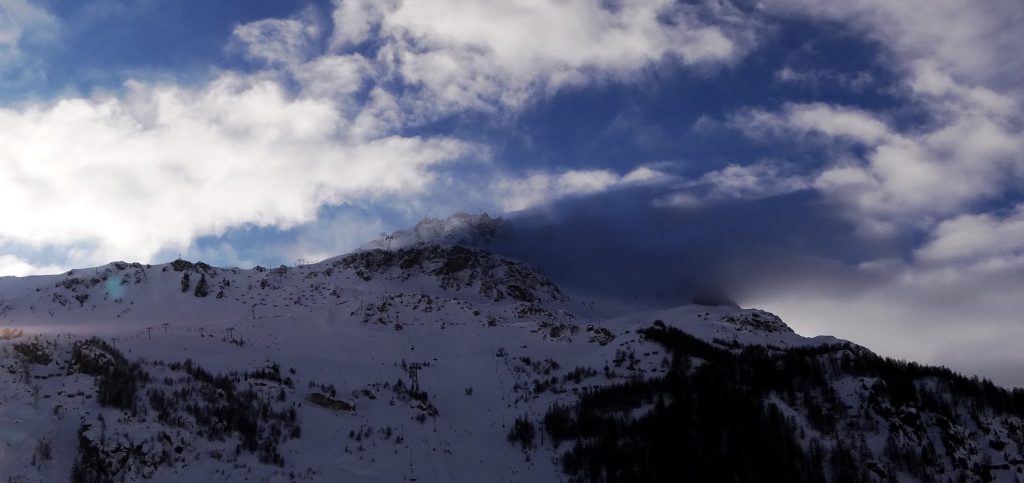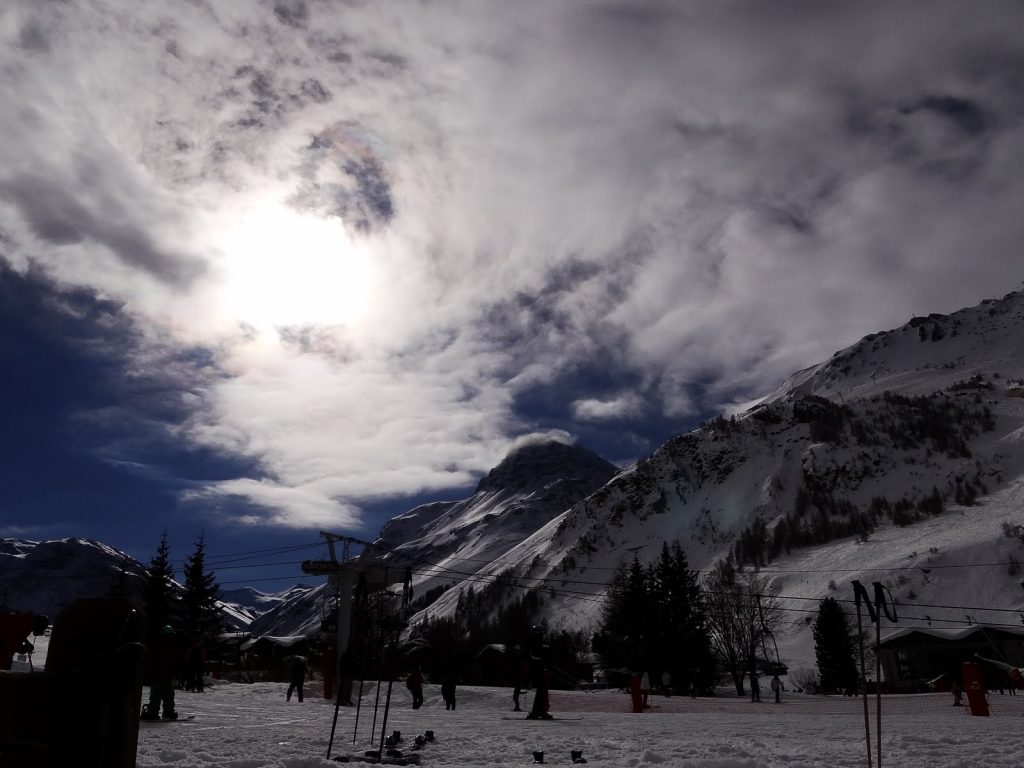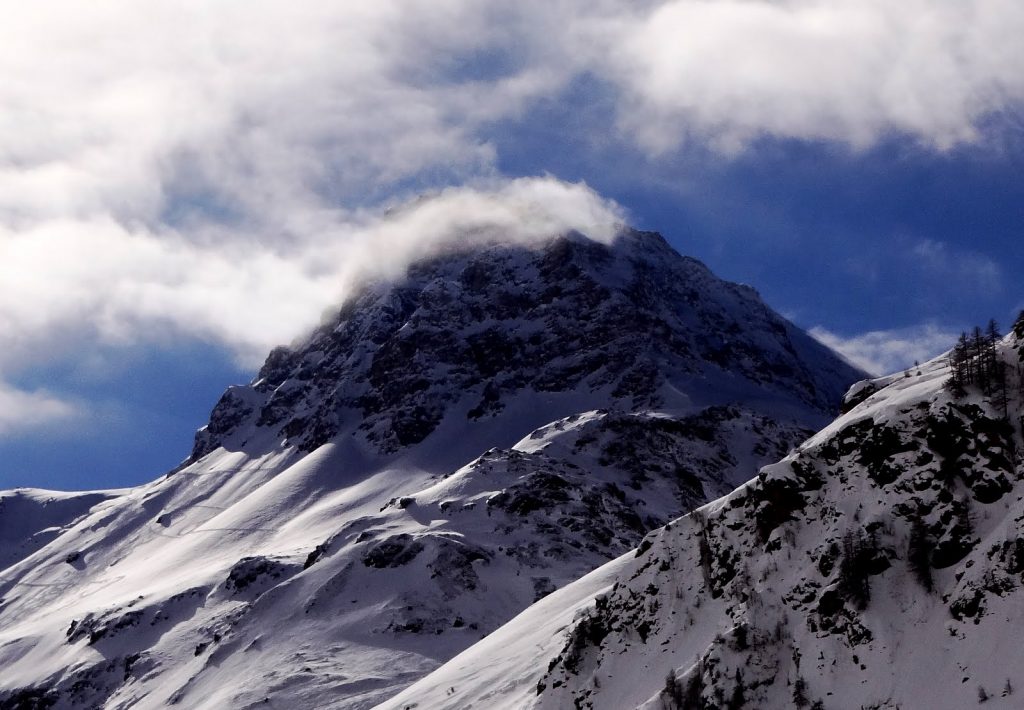Alex, JJ
Picking up the pieces
The two boys returned after a day of rest and were both completely thrown off with the poor visibility when skiing in the clouds. I knew that JJ was still likely to be weak and fragile, but he was clearly straggling behind more out of habit than anything else. This problem was largely dealt with by putting him directly behind me when skiing and not letting him slip off the back and descend the mountain at his own pace. Alex was full of unnecessary fears and concerns covering everything from collision to visibility – so we had to address that directly.
Face de Bellevarde making a shadow
Mind Training
While we resumed exercises in skating, sideslipping and pivoting – all with a view to eliminating the snowplough tendencies and develop useful skills in place – the main theme of the morning was about dealing with fear and how to train the mind. (In the video Alex does a good pivot from the uphill edge on his left foot. JJ is practically parallel in skiing and Alex is much more parallel when he skis behind me.)
Physical skills are trained into body memory so that when a specific situation arises we act in an appropriate manner. Without progressive skill development over time then acting this way would be impossible. It’s very strange that people don’t realise that the mind is also subject to programming and that given a specific situation the mind will respond according to its programming.
Physical skills are lodged in the body in such a way that we are not aware of them. If you are trained to play a musical instrument you can pick it up and play without even thinking about music. Your conscious mind can be completely elsewhere. Most of our behavioural programming is lodged in the unconscious mind in a similar manner – and this often surprises us and catches us out. We need to program our behaviour every bit as much as our body. This begins by recognising that there is programming to be done.
Alex has a fertile imagination but the little voice inside his head is randomly selecting all sorts of directions. Fear is NOT normal – it is a suggestion that grows in the mind – if allowed to. It grows until it paralyses the body and the mind itself. Alex needs to use his imagination to reinforce his strength – not to break it down. Constantly feeding yourself with negative views of yourself will guarantee negative behaviour when under duress. The mind has to be trained with respect to positive outcomes through visualisation using all of the senses – seeing, feeling, hearing, proprioception – and in full awareness of the purpose behind this. Once fear takes hold and the unconscious mind gets going – no amount of “self control” will stop it. Only the mind prepared and trained in advance will cope.
We began Alex’s mind training immediately. JJ followed this all along – but he seems to have a pretty positive inner dialogue going on already. On a practical level Alex responded well on being told to focus on the feelings in his body rather than than what he could see. Part of strengthening the body-mind connection is through “sensing” the body – attentively observing what you feel. A strong body-mind connection centres and grounds a person – strengthening their sense of identity and confidence.
Fiona, Ian, Alex
Fiona had been traumatised eventually in ski school group lessons and decided to drop out.
Ian had been traumatised 20 years ago or so and had dumped skiing for surfing.
Little Alex, age 5 had been traumatised in group lessons immediately and dropped out – very wisely!
Skating
We began by stepping the skis in a circle – opening the tips, diverging the skis and then closing them together again. I showed this by putting a pole in the snow behind me and using it as the centre point of a circle that I’d make with my tails always close to the pole. This exercise was chosen because everyone here would have a strong tendency to converge the skis into a snowplough shape and I wanted to work directly against that tendency.
Fiona and Ian had a lot of difficulty in controlling the skis, feet, legs and body in a manner that would make this coordination possible. For Ian it was partly a case of excessive unconscious muscular tension and for Fiona it was partly lack of awareness of the necessary mechanisms. For both there was a strong reflexive reaction against standing and sliding on one leg – which rendered skating much more difficult. Little Alex was actually doing quite well but his skis were really not sliding at all unfortunately. Skiing is really an evolved form of skating. It is essentially a “one leg” at a time activity – like running – and “two-footed-ness” spells trouble. The more the skills for basic skating are developed the better the skier will progress. Even when a good skier is apparently on two feet – the body is oriented through one leg only – except when straight running.
Adductors and Centre of Mass
Skating requires awareness of the adductor muscles on the inside of the legs – and so does simply holding a ski on its inside edge. The shaft of the ski boot running up the leg is always trying to pull the knee outwards and allow the ski to flatten on the snow – so the adductors are required to be active to counter this. To simply skate forwards the body has to fall forwards between the skis and then a leg stepped forwards to compensate. This is an elementary way to start to become familiar with the active role of the centre of mass and the use of the legs for ski edge control. Skiing is really just a prolonged falling of the body inwards – sustained by the ski itself bringing the skier back up.
Feet
After a while it was clear that Fiona didn’t really understand what to do with the feet – so we stopped for a while in a café for me to show this with the boots off. The boys went through the same lesson on day two so all of the details are covered in the blog for that day.
Dynamics
We ran through the basic static exercises for dynamics (shoulders etc.) which are also detailed in previous pages of the blog this week. Ian was progressively relaxing and controlling his feet better so as to support his movements with the centre of mass. This led to some reasonable parallel turns at the end of the session. He remained uneasy on his left leg and exhibited a strong upper body rotation into the turn when standing on the left leg – a problem simply caused by feeling less confident on the left side. Fiona in contrast was quite successful on her left leg but was practically completely unable to move her centre of mass into the turn when standing on her right leg. This problem is usually caused by searching for constant security over the right foot and not wanting to “fall” over to the left. The interesting thing here is that by working towards the correct mechanics it is possible to clearly identify any technical issues that crop up.



